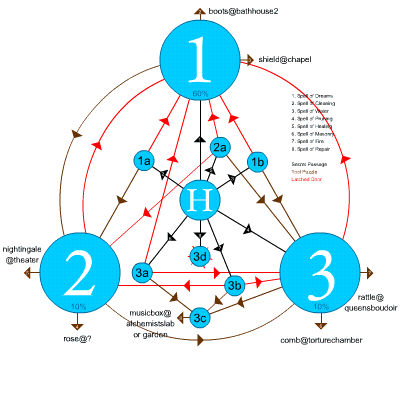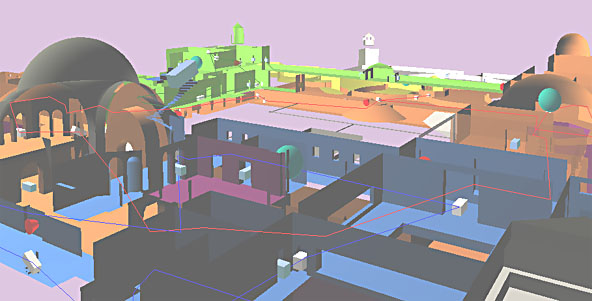| Tale of Tales “8” VAF Mile Stone Plan |
REPORT
|
Step 7: "Exploration" (Sep 15-Oct 15) |
| Introduction |
This is the first report after the revision of the content of the mile stone plan as per our proposal in the
mile stone step 6 report. In this mile stone, next to sitting around waiting for Dreamcatcher to come through, we have
|
| The publishers |
|
Whilst the producers at Dreamcatcher Europe are still very enthusiastic about our project, the decision is out of their hands now. From what we've heard from other developers, it is not abnormal that it takes the top executives quite a bit of time to make up their mind. Some of this time might be increased in this case due to a recent switch of legal staff at Dreamcatcher's Canadian office.
In the mean time, if only to have a backup solution, we have been communicating with other publishers as well. We have confirmation that Ubisoft Germany and Eidos UK are evaluating the product as we speak. Ubisoft is one of the largest game publishers in the world. And Eidos is probably the largest in the UK. Ubisoft would be suitable because they have a wide range of games on offer and are not afraid of the occasional experiment. And Eidos is the publisher whose logo has been engraved on the backside of our skulls due to countless hours of playing the very first Tomb Raider. We have also been honoured by negative answers from Activision and Vivendi Universal (two gigantic game publishers). Both seemed to genuinely like the title but declined to offer us a deal because they did not believe that “8” had sufficient mass market appeal (and apparently the mass market is the only market they are interested in). Smaller publishers would obviously be more suitable for this project. But, as we have experienced before, they seldom have the financial means to support production of “8”. And there are very little medium-sized developers. Dan Marchant compares them to catterpillars, hungry for success, with the desire to turn into a butterfly as soon as possible. “8” probably needs one of these caterpillar publishers who are about to turn into a butterfly. One that has enough courage and enough cash at the same time. Ideally, though, “8” should be published by a company who targets a niche market on purpose. And Dreamcatcher is one of those few companies that does this with its "Adventure Company" brand. If Dreamcatcher does not come through by the end of the month, we should probably start taking the smaller publishers more seriously and see if we can come up with some kind of collaborative publishing deal. |
| The team |
In preparation for production, we have started to look for additional team members.
We haven't made our final choice yet, but we have found several very suitable candidates for the jobs of
The job of the producer/project manager with us consists of:
|
| The design |
|
We have worked with
International Hobo
on a redesign of the structure and the gameplay in “8” with an eye on both reducing the costs and expanding the potential target audience. The result is a much tighter game design that will be much more enjoyable for many more people, without compromising on the artistic soul of “8”. The major change is that the game world will not be fully accessible from the start of the game as it is feared that this kind of freedom will lead to the player feeling lost, not knowing what to do. The new structure will carefully and almost imperceptibly guide the player through both the environment and the game.
Feel free to have a look at the Initial Consultation Document concerning the ideas proposed by International Hobo. Some things in that document need changes and others more details, but overall we feel that their analysis of the game and solutions for its problems are "spot on", to use the words one of one of our British producer candidates.  Structure with three "logical loops" as proposed by International Hobo. Brown lines are puzzles, red lines are latched doors and black lines secret passages. The blue disc labeled "H" in the middle is the central Hub of the game (the Mausoleum). We have succeeded in producing an implementation in the existing game world of the new structure, with minimal changes to the original layout. As you can see, the game now only requires slightly over 100 rooms rather than the original 250. |
| The documentation |
|
After some technical problems with Usemod, the "Wiki" software that we have been using to
document
the game's design and everything else related to it, we have switched to another Wiki application called WikkiTikkTavi (yes, they all have silly names like that). This one is written in PHP and stores the information in a MySQL database. Which will be much more robust and versatile than the Perl and ASCII approach of Usemod.
We have used the incompatibility in formats between these two applications as an extra motivation to clean up our documentation.
Now we are structuring the
new document
so that it is suitable for use during production.
The idea is to
Next to this text-based documentation, we have also built a new "3D map" based on the structure proposed by International Hobo. This includes dividing the game world into three zones: "logical loops", that form circular chains of rooms that guide navigation and replace the open environment we had before. This map is made with the same software as the game engine. As such all of the geometry of the rooms is already in place to make a first blocked out version of the complete game, early in the production process.  3D map of the game world, displaying the three "logical loops" (red, green and blue), the doors and puzzles (cubes and cones) and the location of the "Alcove Objects" (spheres). |
| The organization |
|
Another major thing that we have been doing is look into ways in which the production can be organized.
A significant part of this has been, and still is, research into software that can help us do this. There are many applications available but they all lack features. Especially with regards to our need of a "virtual office", an internet based environment that our homeworkers can use to communicate with us and each other.
Another aspect has been trying to figure out how to structure production to garantee both artistic success and within-budget delivery. With regards to this, we have been "abusing" our experienced producer candidates (see "The team") by extracting as much information as we could from them during job interviews. This has been most enlightening. Depending on consultation with experts and key team members, we would be scheduling the production in three major parts:
The long second phase will be divided up into 4 milestones, each delivering the complete game in a more and more finalized state. |
| Conclusion |
|